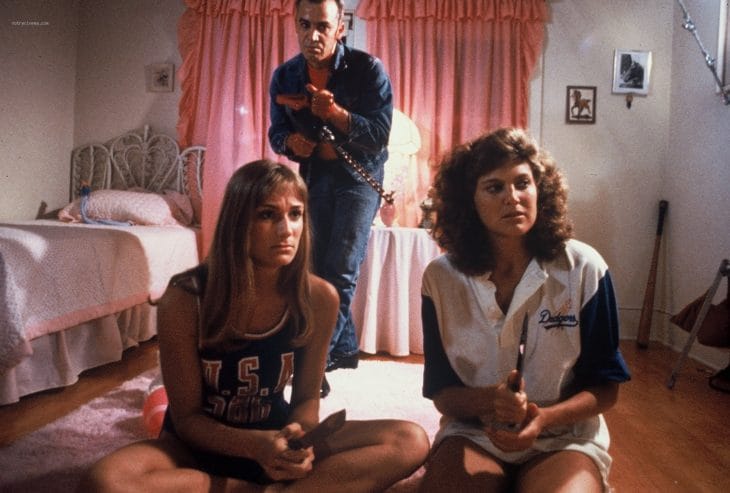Be Our Guest: The Slumber Party Massacre (dir. Amy Holden Jones, 1982)
Nothing on this earth could compel me to spoil the pizza-guy scene.

A good slasher movie, I’ve come to realize, works a lot like a musical. You have your between-scenes patter, which should be light and amusing and ultimately not that consequential, and then, you have your big numbers — the kills.
At its core, the appeal of a death in, let’s say, Friday the 13th Pt II is no different than the appeal of “Be Our Guest” in Beauty and the Beast. You’re watching it for craft, for staging, for spectacle. You know what’s going to happen (someone is going to sing a song; someone is going to die) but you don’t yet know how (chandelier of chorus-line forks; machete through the face that knocks their wheelchair down a flight of stairs). Like musical numbers, slasher kills exist in an elevated reality, with their own cartoon physics. Like musical numbers, the best ones don’t always go to the main characters. (Lumiere the Talking Candlestick is not the protagonist of Beauty and the Beast by a long shot; no particular glory adheres to being Wheelchair Machete Teen, but he’s the one you’ll remember when the credits roll).
Not everyone gets the appeal; the idea of paying to watch a people die, even fictional people dying highly contrived and unrealistic deaths, makes lots of us uncomfortable. I empathize. Musicals make me uncomfortable, which is why the first example that comes to mind is a cartoon that came out when I was in elementary school.
When I watch a musical, I’m thinking about how hard everybody had to work to learn that dance, and how embarrassing it can be to sing in public, and how many tryouts these actors go on, how many of them have probably been trying out and attempting to get into the business since grade school, all to do this, this massively serious thing in their lives, The Musical Number, which I now have to find entertaining, even though I don’t like musicals, and when I think about all that — even if it’s a highly acclaimed musical with a top cast; even if it’s a film, and the actors can’t see me — I start worrying that they’ll fail, and all their work will have been for nothing, or that I just won’t seem like I enjoy the song enough, and they’ll know, and they’ll feel like total idiots, and when I think about that, when I contemplate my ability to crush the spirits of every single person on stage in this musical, that is when I have a full-blown panic attack.
I am not without empathy, is my point; I experience intense, painful, vicarious-cringe empathy for a guy doing a goofy little dance in the background of Oklahoma. But I can watch slasher movies, because everyone involved in a slasher movie is aware that they’re making something cheesy and cheap and trashy. There’s no bar to clear, no risk of failure; the genre is inherently exploitative and stupid, and the best films embrace this and have fun with it. Out of every horror subgenre, slashers are the most likely to be funny.
This is all to say: The Slumber Party Massacre was, famously, intended to be a lesbian feminist parody of misogynistic slasher movies. The script was written by Rita Mae Brown, a member of the Lavender Menace, and the author of Rubyfruit Jungle. Also famously, no-one in Hollywood could actually tell the script was a parody. When someone actually filmed The Slumber Party Massacre — a female director! In 1982! — the result looked, basically, like a slasher movie. Just, you know, more so.